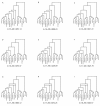Nuclear versus mitochondrial DNA: evidence for hybridization in colobine monkeys
- PMID: 21435245
- PMCID: PMC3068967
- DOI: 10.1186/1471-2148-11-77
Nuclear versus mitochondrial DNA: evidence for hybridization in colobine monkeys
Abstract
Background: Colobine monkeys constitute a diverse group of primates with major radiations in Africa and Asia. However, phylogenetic relationships among genera are under debate, and recent molecular studies with incomplete taxon-sampling revealed discordant gene trees. To solve the evolutionary history of colobine genera and to determine causes for possible gene tree incongruences, we combined presence/absence analysis of mobile elements with autosomal, X chromosomal, Y chromosomal and mitochondrial sequence data from all recognized colobine genera.
Results: Gene tree topologies and divergence age estimates derived from different markers were similar, but differed in placing Piliocolobus/Procolobus and langur genera among colobines. Although insufficient data, homoplasy and incomplete lineage sorting might all have contributed to the discordance among gene trees, hybridization is favored as the main cause of the observed discordance. We propose that African colobines are paraphyletic, but might later have experienced female introgression from Piliocolobus/Procolobus into Colobus. In the late Miocene, colobines invaded Eurasia and diversified into several lineages. Among Asian colobines, Semnopithecus diverged first, indicating langur paraphyly. However, unidirectional gene flow from Semnopithecus into Trachypithecus via male introgression followed by nuclear swamping might have occurred until the earliest Pleistocene.
Conclusions: Overall, our study provides the most comprehensive view on colobine evolution to date and emphasizes that analyses of various molecular markers, such as mobile elements and sequence data from multiple loci, are crucial to better understand evolutionary relationships and to trace hybridization events. Our results also suggest that sex-specific dispersal patterns, promoted by a respective social organization of the species involved, can result in different hybridization scenarios.
Figures



References
-
- Davies AG, Oates JF. Colobine Monkeys - Their Ecology, Behaviour and Evolution. Cambridge: Cambridge University Press; 1994.
-
- Groves CP. Primate Taxonomy. Washington DC: Smithsonian Institution Press; 2001.
-
- Groves CP. A Theory of Human and Primate Evolution. Oxford: Clarendon Press; 1989.
-
- Jablonski NG. Natural History of the Doucs and Snub-Nosed Monkeys. New Jersey: World Scientific Publishing Company; 1998.
Publication types
MeSH terms
Substances
Grants and funding
LinkOut - more resources
Full Text Sources

